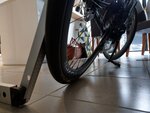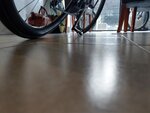Last post on Creo range, I promise....
Just showing again that the 80mi (128km) range for just the internal battery advertised by
Specialized is for me very conservative and in typical conditions I can go much further.
This is from a fairly average ride yesterday, although there was some headwind/tailwind. Settings are as usual, Sport selected with settings shown. Just using the internal battery.
Bike turned on at start of ride and nothing touched after that. I was riding with one other person, side by side all the way so no drafting at all.
On the graph below red is my heart rate and grey is my speed.
There was a slight headwind during the first part of the ride and you can see from the graphs below I was sticking close to the 27.5km/hr where the boost cuts out.
The middle part of the ride (from about 38km to 48km mark) has some hills (up to 20%) and then a tailwind home so frequently above the 27.5km/hr motor cutoff.


At 33km have used 13% battery

At 40km with first climb, have used 20%

End of second climb 33% battery usage

At the coffee shop, used very little battery between 48km and 87 km due to tailwind.
Extrapolating these figures, on this type of ride I could expect something like 100/41 x 87 or just over 200km range.




I indeed have got a cowbell!

 At 33km have used 13% battery
At 33km have used 13% battery At 40km with first climb, have used 20%
At 40km with first climb, have used 20% End of second climb 33% battery usage
End of second climb 33% battery usage At the coffee shop, used very little battery between 48km and 87 km due to tailwind.
At the coffee shop, used very little battery between 48km and 87 km due to tailwind.